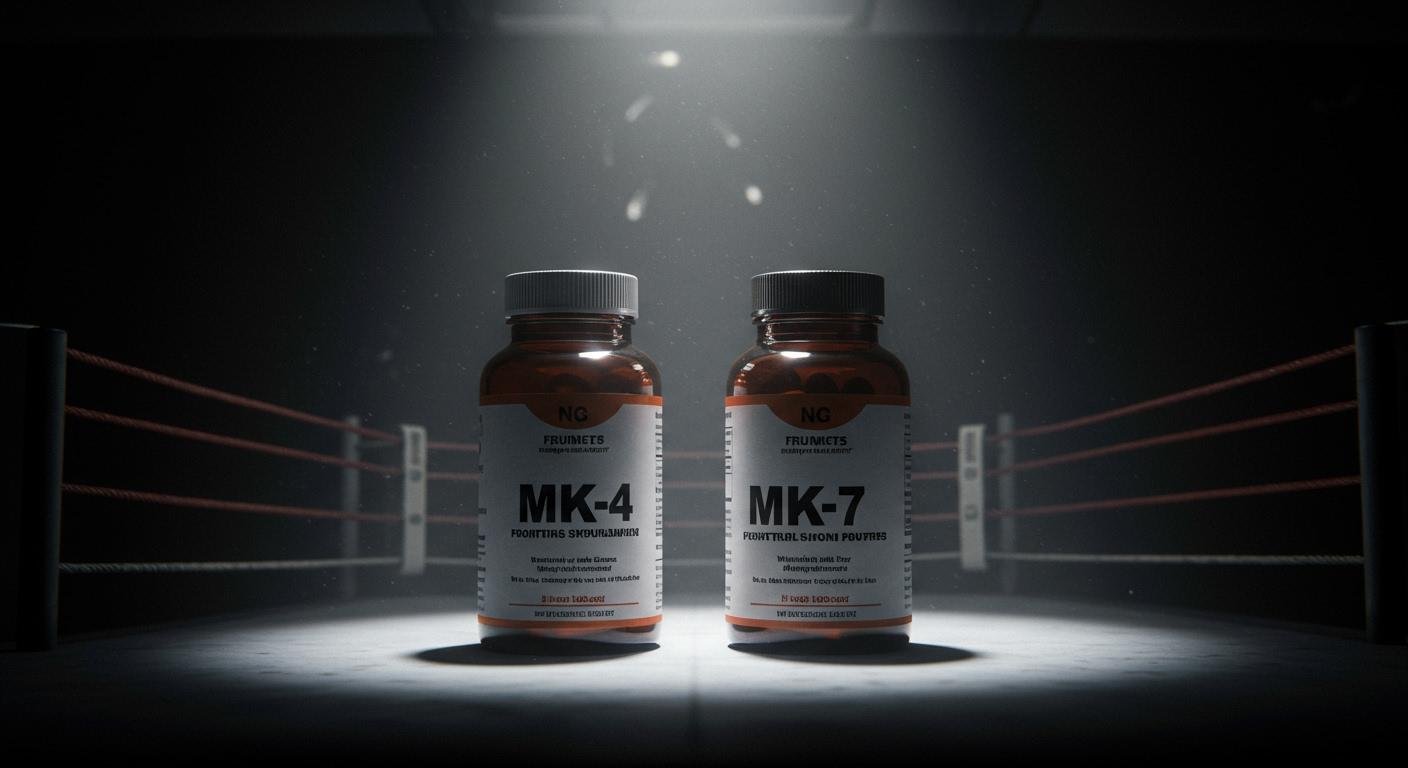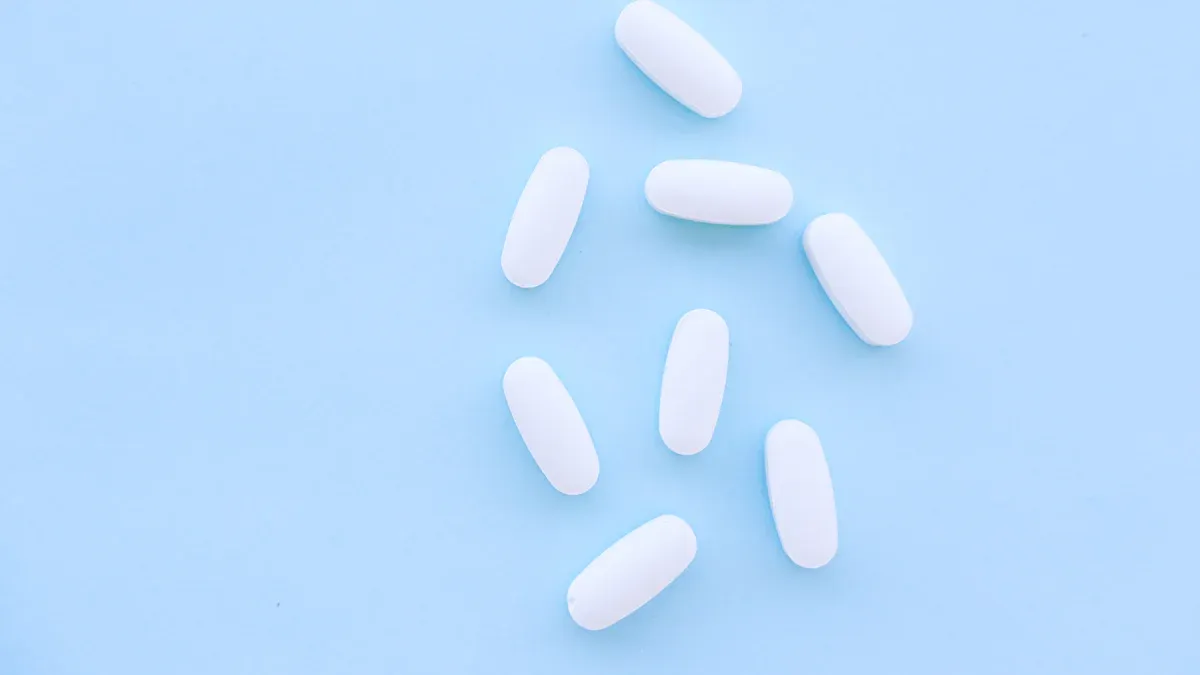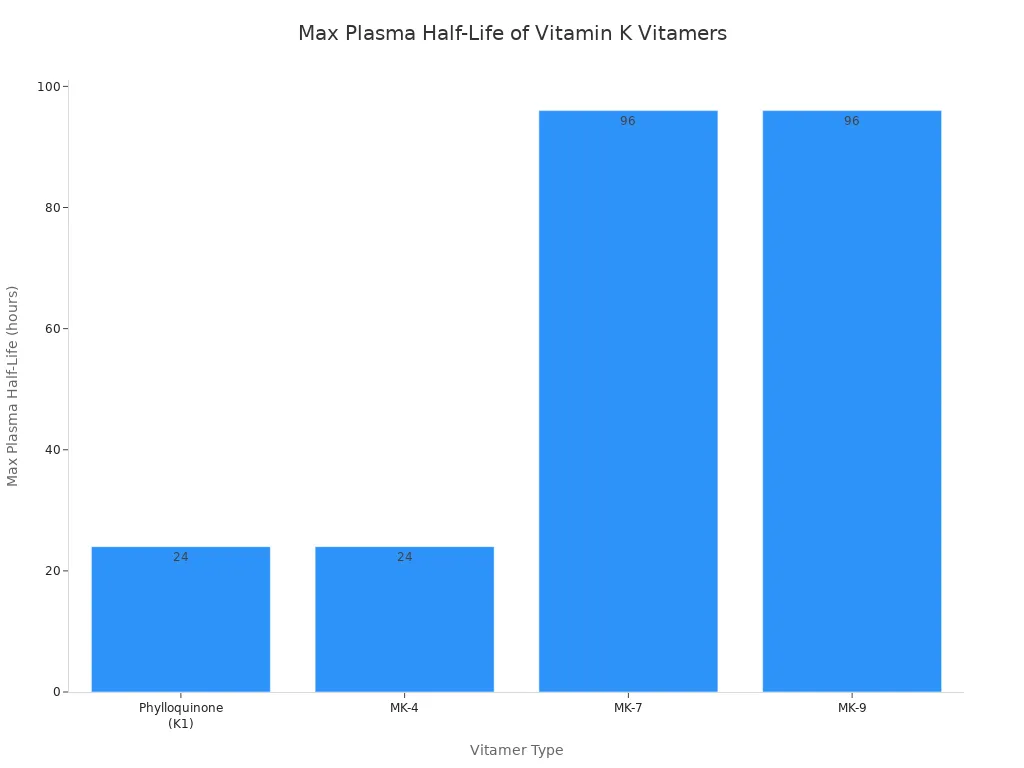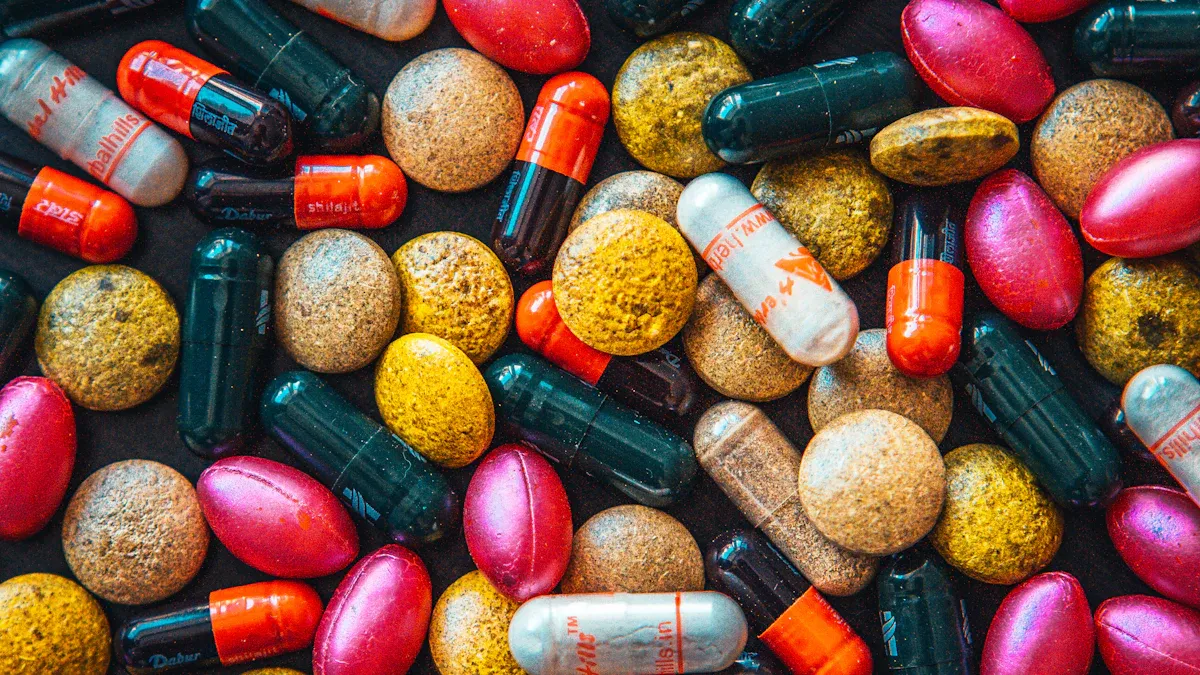MK-4 vs MK-7 A Vitamin K2 Showdown
Table of Contents

The topic of vitamin k2 explained often creates confusion for consumers. The market for these supplements is expanding rapidly, making the choice more relevant than ever.
| Metric | Value |
|---|---|
| Global Vitamin K2 Market Size (2024) | USD 292.4 million |
| Projected Market Size (2030) | USD 602.0 million |
| Projected CAGR (2025-2030) | 13.5% |
The Verdict: For daily supplementation, menaquinone-7 (MK-7) is the best form for vitamin k2. Its ability to stay in the body longer provides more stable benefits.
This showdown between MK-4 (menaquinone-4) and the superior MK-7 involves key differences in structure and action within the body.
VITAMIN K2 EXPLAINED: THE TWO MAIN FORMS

The topic of vitamin k2 explained involves understanding its two primary forms. Vitamin K2 is a vital nutrient. It performs several critical jobs inside the body. Its main functions include:
- Bone Metabolism: It activates proteins that guide calcium into bones and teeth.
- Cardiovascular Health: It helps prevent calcium from building up in arteries.
- Blood Coagulation: It plays a key role in the blood clotting process.
These actions depend on which form of the vitamin is present. The two most common forms in supplements are menaquinone-4 and menaquinone-7. They have different structures and behave differently in the body.
MENAQUINONE-4 (MK-4): THE SHORT-CHAIN FORM
Menaquinone-4 is the short-chain version of vitamin K2. Its chemical structure contains four smaller parts called isoprenoid units. An interesting fact about mk-4 is how it gets into our tissues. The body does not rely on getting menaquinone-4 directly from food. Instead, it can create mk-4 on its own. It takes other forms of vitamin K, breaks them down into a precursor molecule called menadione, and then converts that precursor into mk-4 inside various tissues. This internal synthesis is a unique feature of this form.
MENAQUINONE-7 (MK-7): THE LONG-CHAIN FORM
Menaquinone-7 is the long-chain counterpart. As its name suggests, the structure of menaquinone-7 features a longer side chain with seven isoprenoid units. This structural difference is key to its superior action. Unlike the body-synthesized mk-4, mk-7 comes primarily from the diet. Specific bacteria produce mk-7 during the fermentation process of certain foods. This is a core part of the vitamin k2 explained discussion.
Bacterial Powerhouses 🧑🔬 The production of mk-7 is a microbial process. Bacteria like Bacillus subtilis, often found in the Japanese fermented food natto, are excellent producers of this nutrient. Other bacteria, such as Lactococcus lactis, also create it in fermented dairy.
This bacterial origin makes dietary sources and supplements the main way to get effective levels of this long-lasting vitamin.
KEY DIFFERENCES: HALF-LIFE AND BIOAVAILABILITY
The body absorbs both MK-4 and MK-7, but their actions afterward are completely different. This difference comes down to two critical factors: bioavailability and half-life. Bioavailability measures how much of a nutrient the body can actually use. The half-life tells us how long that nutrient stays active in the bloodstream. These two metrics reveal why one form of K2 is far more effective for daily use.
ABSORPTION AND PEAK LEVELS
The journey of Vitamin K2 begins with absorption in the gut. As a fat-soluble vitamin, its uptake depends on the presence of dietary fat. The body packages K2 with fats into special particles that travel into the bloodstream. However, a crucial point is that not all vitamin k2s are equally well absorbed.
Scientific studies highlight a stark contrast in bioavailability between the two forms. Researchers have directly compared how the body handles them at typical nutritional doses.
| Study Design | MK-4 Serum Levels | MK-7 Serum Levels |
|---|---|---|
| Single 420 mcg Dose | Not detected | Increased significantly; detected for 48 hours |
| Daily 60 mcg Dose (7 Days) | Did not increase | Increased significantly |
These findings are clear. At doses common in supplements, mk-7 effectively raises serum vitamin k levels. The same is not true for its counterpart. This research demonstrates the poor bioavailability of nutritional mk-4. For a supplement to work, it must first reach the bloodstream in sufficient amounts, giving mk-7 a major advantage.
HALF-LIFE: THE STAYING POWER TEST
Once a nutrient enters the blood, its half-life determines its staying power. A nutrient’s half-life is the time it takes for the body to clear out half of the initial amount. Here, the showdown becomes a landslide victory for MK-7.
- MK-4 has a very short half-life of only 1 to 2 hours. It appears in the blood quickly and disappears just as fast.
- MK-7 has an impressively long half-life of about 3 days (72-96 hours).
This dramatic difference means MK-7 circulates in the body for days, while MK-4 is gone in a matter of hours.

THE BONE HEALTH DEBATE
The role of Vitamin K2 in bone health often creates debate. Research results can seem contradictory. This happens because the two main forms, MK-4 and MK-7, work very differently at various doses. Vitamin K2 is essential for strong bones. It activates a key protein through a process called carboxylation.
This activation process is critical for bone mineralization.
- Vitamin K2 helps an enzyme called γ-glutamylcarboxylase work properly.
- This enzyme changes a bone protein called osteocalcin.
- The change allows osteocalcin to bind to calcium in the bone matrix.
- This binding process is what helps make bones strong and dense.
Without enough Vitamin K2, osteocalcin remains inactive. It cannot direct calcium into the bones effectively. This is where the showdown between menaquinone-4 and menaquinone-7 becomes most important.
HIGH-DOSE MK-4 FOR BONES
Some studies on bone health use a form called menaquinone-4. These studies, however, use very large amounts. In Japan, doctors sometimes use a pharmacological dose of 45 mg (45,000 mcg) of mk-4 per day to treat osteoporosis. This is a therapeutic approach, not a standard nutritional supplement dose.
Even with this high-dose strategy, the results are mixed. Some Japanese studies showed benefits. However, a large study found that adding 45 mg of mk-4 to another bone medication did not provide any extra benefit in reducing fracture risk.
Safety at High Doses 💊 Clinical trials show that even a high 45 mg daily dose of mk-4 is generally safe. Some people report minor side effects like nausea or an upset stomach. People taking blood-thinning medications like warfarin should avoid high-dose vitamin K, as it can interfere with their medicine.
The use of high-dose mk-4 is a specific medical treatment. It is not a practical approach for daily supplementation due to the massive dose required and its very short half-life.
MK-7 FOR DAILY SUPPORT
In contrast, menaquinone-7 shows significant benefits at much smaller, more practical doses. This makes it the superior choice for daily support of bone and cardiovascular health. Clinical trials demonstrate that nutritional doses of mk-7 are highly effective.
| Form | Typical Use | Daily Dose Range |
|---|---|---|
| MK-4 | Pharmacological Therapy | 45,000 mcg |
| MK-7 | Nutritional Supplement | 90 – 360 mcg |
A key three-year study gave postmenopausal women just 180 mcg of MK-7 daily. The results showed clear improvements in bone mineral density and bone strength. Other studies confirm that mk-7 effectively reduces the amount of inactive osteocalcin in the blood, proving it is working to support the bone-building process.
The benefits of menaquinone-7 extend beyond bones. Studies also show it supports cardiovascular health.
- It helps reduce arterial stiffness in healthy adults and kidney patients.
- In one trial, 180 mcg of MK-7 per day helped maintain arterial flexibility.
- Another study found that 720 mcg of MK-7 daily slowed the progression of coronary artery calcification in high-risk individuals.
This dual-action benefit makes MK-7 a uniquely powerful nutrient. It works to keep calcium in the bones and out of the arteries. For daily supplementation, its long half-life and proven effectiveness at low doses make it the clear winner for long-term health.
SOURCES: FOODS VS. SUPPLEMENTS

Getting enough Vitamin K2 can be a challenge. People can find it in certain foods or turn to supplements to meet their needs. Understanding both sources helps in making an informed health decision.
FINDING K2 IN YOUR DIET
The typical Western diet often lacks sufficient Vitamin K2. Studies show that a large portion of the Western population may not get enough of this nutrient due to modern dietary habits. The body’s own bacteria can produce some K2, but it is not well absorbed. This makes food the main source for most people. Key dietary sources include specific fermented foods, cheeses, and animal products.
However, the amounts can vary greatly. Natto, a fermented soybean dish, is an exceptional source of highly bioavailable MK-7.
| Food Source | Typical MK-4 Content (μg/100g) |
|---|---|
| Chicken Eggs (Australia) | 32.6 |
| Butter (Australia) | 24.7 |
| Hard Cheese (Various) | 4–10 |
| Beef (Australia) | 16 |
CHOOSING THE RIGHT K2 SUPPLEMENT
Supplements offer a reliable way to fill the dietary gap. When choosing a product, the form of the vitamin is critical. Vitamin K2 exists in different molecular shapes called isomers. The two main shapes are ‘trans’ and ‘cis’.
The Active Form ✅ Only the
all-transform of Vitamin K2 is biologically active. The ‘cis’ form has almost no effect in the body. Natural sources like natto contain 100% of the active all-trans form.
Quality supplements replicate this natural structure. Consumers should look for products that specify they contain “all-trans” mk-7. This ensures the body receives the most effective and biologically active form of the nutrient for bone and cardiovascular health.
The vitamin k2 explained topic shows clear differences. The body makes short-acting menaquinone-4 (mk-4). Fermented foods provide long-acting menaquinone-7 (mk-7). Its superior half-life and ability to create stable blood levels make it the best form for vitamin k2. This stability supports bone and cardiovascular health effectively.
Final Recommendation 🏆 Consumers seeking the best form for vitamin k2 should choose supplements containing vitamin k2 mk-7. This ensures they receive the most efficient and practical nutrient for their daily health goals.
FAQ
Can a multivitamin provide enough Vitamin K2?
Many multivitamins contain low amounts of Vitamin K2. They might also use the less effective MK-4 form. People should check supplement labels. A good product specifies the dose of menaquinone-7 (MK-7) to ensure adequate intake for health benefits.
Do Vitamin K2 and Vitamin D interfere with each other?
No, these vitamins work together as a team. Vitamin D3 improves calcium absorption into the blood. Vitamin K2 then activates proteins that guide that calcium into the bones and teeth. This partnership supports both bone and cardiovascular health.
Is natto the only good food source of MK-7?
Natto is the richest food source of MK-7. However, other fermented foods also provide this nutrient.
Other MK-7 Sources 🧀 Certain hard and soft cheeses, like Gouda and Brie, contain MK-7. Some types of sauerkraut may also offer small amounts of this important vitamin.
Why is the ‘all-trans’ form of MK-7 important?
The ‘all-trans’ label refers to the vitamin’s molecular shape. This is the only biologically active form the body can use effectively.
Remember: The ‘cis’ form is inactive and provides almost no health benefit. Quality supplements use
all-transMK-7 to guarantee effectiveness.

Poseidon
Master of Nutritional Epidemiology, University of Copenhagen, Herbal Functional Nutrition Researcher
Focus: The scientific application of natural active ingredients such as Tongo Ali, Horny Goat Weed, and Maca to sexual health and metabolic regulation.
Core Focus:
Men: Use a combination of Tongo Ali (an energizing factor) + Maca (an energy reserve) to improve low energy and fluctuating libido.
Women: Use a combination of Horny Goat Weed (a gentle regulator) + Maca (a nutritional synergist) to alleviate low libido and hormonal imbalances.
Stressed/Middle-Aged Adults: This triple-ingredient synergy supports metabolism, physical strength, and intimacy.
Product Concept:
Based on traditional applications and modern research (e.g., Tongo Ali promotes testosterone-enhancing enzyme activity, and icariin provides gentle regulation), we preserve core active ingredients and eschew conceptual packaging—using natural ingredients to address specific needs.
Simply put: I'm a nutritionist who understands "herbal actives." I use scientifically proven ingredients like Tongo Ali, Epimedium, and Maca to help you make "sexual health" and "nutritional support" a daily routine.
